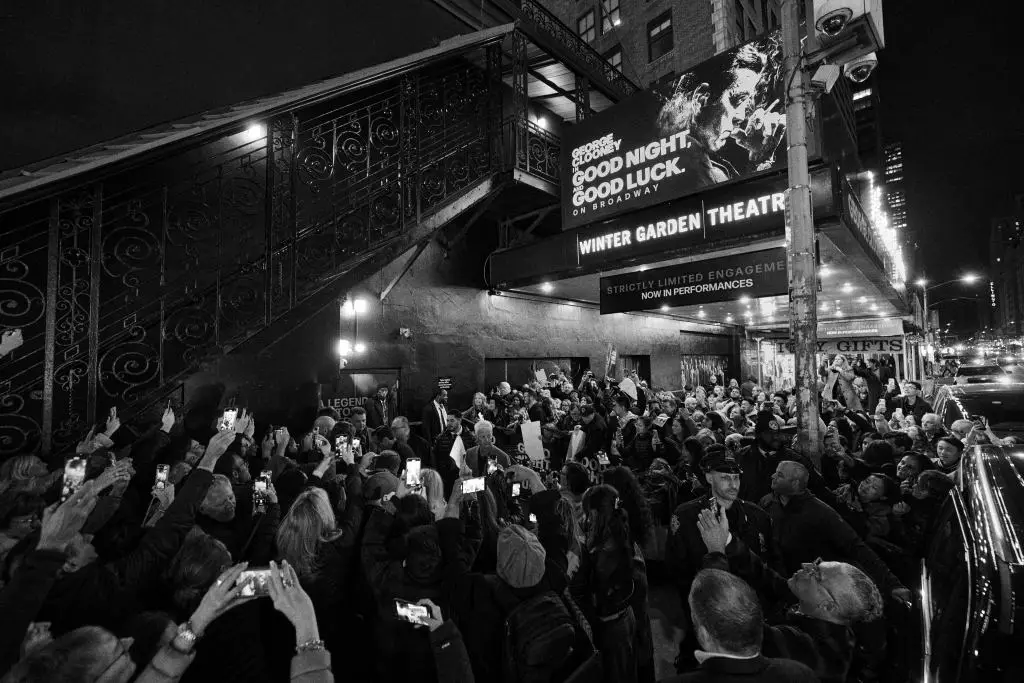Broadway has recently become a gold standard for theatrical success, not only dazzling audiences with stellar performances but also raking in astounding box office numbers. This spring, the famed theater district is experiencing a major revenue surge as shows like George Clooney’s “Good Night, And Good Luck” quickly join the elite $2 Million Club. With only five preview performances under its belt, the show has made an impressive entrance into the market, underscoring the potent combination of celebrity power and timely storytelling. Meanwhile, Denzel Washington and Jake Gyllenhaal’s “Othello” has also made waves, consistently hitting the same impressive financial heights shortly after its debut.
The financial success is exhilarating, yet it beckons an important question: has Broadway effectively become a playland for the affluent? With ticket prices escalating, shows are becoming inaccessible to many passionate theatergoers. The extravagance surrounding these productions creates a dual narrative—one of accessibility for all movie lovers and the other of elitism that risks alienating lower-income patrons.
Celebrity Influence: The Draw of Star Power
Why is money flowing so freely into Broadway right now? The allure of big-name stars is indisputably a crucial factor. Audiences are clamoring for the chance to watch famed actors take the stage, and producers are more than happy to capitalize on this demand. The average ticket price for productions featuring A-list actors like Clooney or Washington easily skyrocket. For example, “Othello” boasts an eye-watering average ticket price of $338.83, far surpassing the more reasonable average ticket price of $134.96 for the remaining 31 shows.
Star-studded casts do deliver spellbinding performances, but they also risk creating an environment that prioritizes monetary gain over the art form itself. It raises ethical considerations: should the theater community strive to cultivate diverse artistic talents, or continue to rely heavily on recognized names for guaranteed box office hits? Evidently, the current trend points towards the former, but at what cost?
Audience Engagement: Are We Losing the Everyman?
As ticket prices reach stratospheric heights, the demographic of Broadway attendees may be shifting away from the casual theater enthusiast to the affluent elite. This change could lead to a loss of the authentic Broadway experience, one wherein every social class could unite in the shared appreciation of performance art.
With productions like “Glengarry Glen Ross” hitting near-record earnings and filling almost all available seats, it can be tempting to celebrate this financial achievement. Yet, one must question whether headline-grabbing success stories are overshadowing the smaller, innovative works that have long represented the spirit of Broadway. Shows like “Boop! The Betty Boop Musical,” delivering more modest financial figures, still possess the potential to shine a light on the creative individuality that Broadway has championed over the decades.
Now, as “Operation Mincemeat” fills its seats with astonishing capacity while exhibiting impressive sales, one cannot help but wonder how many untold stories are buried in the shadows of the high-budget productions dominating the scene. The dilemma remains: is Broadway a reflection of societal achievement, or merely a mirror of economic disparity?
Ticketing Trends: The Rise of Premium Pricing
The evolution of ticket pricing in recent years has been staggering, with premium tickets now occupying an unsettling space in the market. Productions featuring big-name stars regularly offer premium options priced at nearly $900. “Othello” leads the charge, propping up the demand for luxury theater experiences, and perhaps leading many to believe that Broadway is something meant only for the privileged.
Does this shift signal a movement away from the democratic nature of theater? Ideally, Broadway should remain an arena for spectacular artistic expression accessible to all. However, as ticket prices climb and the successful shows continue to thrive financially, will we witness a homogenized theater culture that caters exclusively to the elite?
Broadway’s current trajectory raises challenging questions about the future of theater as an art form. While the excitement of record-breaking earnings is palpable, the implications for accessibility and diversity necessitate serious contemplation. As one of the world’s most iconic theater districts, Broadway has the potential to not simply attract the wealthy; it can transcend monetary constraints and deliver experiences that speak to the heart of every theatergoer. The challenge lies in achieving that ideal while navigating the complicated landscape of modern entertainment.

